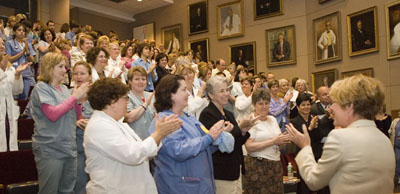State of Nursing at BWH
‘Where We’ve Been and Where We’re Going’

Chief Nursing Officer and Senior Vice President of Patient Care Services Mairead Hickey, PhD, RN, twice outlined the 2007-2008 goals for the Department of Nursing in May, both times to capacity audiences of nurses and staff.
Hickey’s State of the Nursing Department Address—the first of its kind at BWH—is based on feedback she received from nurses throughout BWH. “What’s most important to me is to assure your voices are heard in the decisions made about nursing practice,” she said.
The State of the Nursing Department follows last year’s roll out of the Nursing vision: to provide excellent care to patients and families with the best staff in the safest environment. This vision will guide the department’s work for the next several years.

“Our accountability as a nursing discipline is always to improve care based on new knowledge, so we are continuously building on a foundation that is already strong,” Hickey said. “We will work with nurses in all roles throughout the department in this process.”
Hickey praised nurses for their central role in the world-class care provided by BWH.
“You are with the patient 24 hours a day, seven days a week and know the most intimate details of the patient’s life,” she said. “I envision a day when no team will walk onto a floor and into a patient’s room without asking for the nurse.”
Looking Back
“We’ve been involved in some amazing work over the past year,” Hickey said. Guided by the vision, the department last year accomplished many goals, including:
• Established and strengthened academic partnerships with UMass Boston and Regis College and affiliation with 17 schools of Nursing;
• Involvement of staff nurses in design of the Shapiro Cardiovascular Center;
• Established a psychiatric nursing resource service on start up units including 7AB, 14ABCD and 15ABCD;
• Began finding examples of “excellent nursing care” that will be used for ongoing development of professional practice and education;
• Continued NLN programs in OR, ICUs and ED;
• Completed the first three phases of Defining the Good
Improvements in safety over the past year include:
• Installed 186 ceiling lifts;
• Trained 1,500 staff in eMAR enhancements;
• Trained 1,825 staff in Alaris upgrade;
• Hired oncology resource nurses;
• Added nursery omnicells with unit dosing;
• Completed two hospital-wide pressure ulcer prevalence surveys;
• Conducted successful restraint reduction pilot;
• Demonstrated consistent use of Morse Fall risk scale.
‘Where We’re Going’
Eight major goals form the framework of the department’s work in the coming year:
1. Continue to develop and advance nursing practice. The department will establish forums to ensure nurses’ voices are heard continuously to shape nursing care of patients and families.
2. Develop and implement clinical and educational plans and guidelines for patient-family centered care. With input from more than 500 nurses through focus groups, the department has completed the first draft of a patient-family philosophy statement, which will provide guidance in nurses’ care and approach to family members.
3. Ensure ongoing learning for nurses and staff in all roles. “We will design the education and systems to support nurses to provide the best care possible,” Hickey said. The department aims to expand partnerships with schools of nursing and create the role of visiting professor. “I hope next year we’ll have visiting professors available to advance evidence-based practice and scholarship,” Hickey said.

4. Continuously refine recruitment and retention program. “It’s critical that we continue to recruit and retain excellent nurses and support them in their practice,” Hickey said.
Each year, 250-350 nurses are hired on average. About 14 percent of new hires are multicultural, and the Nursing Department has made it a priority to increase diversity. “Nurses and all members of the care team should reflect the patients we’re caring for,” Hickey said.
The Nursing Department’s turnover rate is 3.5 percent year to date. Right now, the department’s vacancy rate is 3.7 percent, fairly low compared with hospitals really suffering from the nursing shortage with 12 percent to 15 percent vacancy rates.
5. Ensure mutually respectful and effective communication. “No nurse should feel left alone in his or her practice,” Hickey said. “We need to support each other and revel in each other’s successes. We shall not tolerate intimidation and harassment.”
6. Ensure quality, patient safety and care improvement outcomes. Pilots already are underway to reduce pressure ulcers, falls and central line infections in the ICUs.
7. Continue to oversee and ensure safe care environments, including the development and use of clinical innovations and technology. “Nurses are known as leaders in creating a safe environment,” Hickey said. “We will continue to provide input to the hospital on ways to improve patient safety and safe care environments.”
Plans are being developed to roll out eMAR and OE for Oncology and eMAR in Women’s Health, the ED and the PACU.
8. Patient satisfaction: continue progress made in the past year, as patient satisfaction scores with nursing has increased significantly. Compared to other like size academic medical centers, BWH nurses are in the 98th percentile. “Nursing at this hospital is among the best in the country,” Hickey said.
To conclude, Hickey asked that “nurses join in this process to continue to refine and reshape care so that nursing at Brigham and Women’s Hospital stands shoulder to shoulder with any nursing department in this country as a leader among leaders.”

